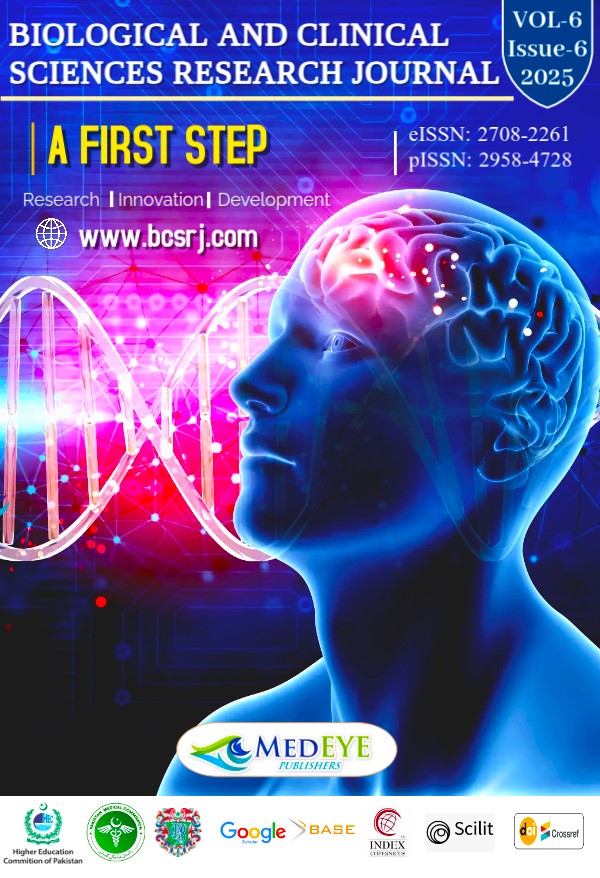Frequency of Multivessel Disease in Patients Presenting with Acute Myocardial Infarction
DOI:
https://doi.org/10.54112/bcsrj.v6i6.1911Keywords:
Frequency, multivessel disease, acute myocardial infarctionAbstract
Acute myocardial infarction (AMI) is a major cause of morbidity and mortality worldwide. Multivessel disease, defined as the involvement of more than one vascular bed including coronary, peripheral, and cerebrovascular circulation, significantly influences prognosis and management strategies in AMI patients. However, local data regarding its frequency remains limited. Objective: To determine the frequency of multivessel disease in patients with acute myocardial infarction. Study Design: Cross-sectional study. Place and Duration of Study: At Punjab Institute of Cardiology, Lahore, Cardiology Department from 15-01-2025 to 15-04-2025. Methodology: This cross-sectional study was conducted after taking ethical approval from the IRB of Punjab Institute of Cardiology, Lahore. This study was done on 120 patients diagnosed with AMI (STEMI and NSTEMI) after taking informed consent. Data was collected using a proforma. Demographic details of patients and frequency of multivessel disease (involvement of more than one vascular bed, including peripheral arterial disease, coronary artery disease, and cerebrovascular disease) were noted. Data analysis was completed using SPSS version 26. Results: Among 120 patients with AMI, 39% patients had coronary artery disease, 17% had peripheral arterial disease, and 9% had cerebrovascular disease. Multivessel disease was found in 13% of the study population. Multivessel disease was more common in older patients, females, those with higher BMIs, and those presenting with NSTEMI; however, none of these associations were statistically significant (p >). Conclusion: This study highlights that a significant proportion of patients with acute myocardial infarction have underlying multivessel disease, emphasizing the systemic nature of atherosclerosis. Identifying the presence of multivessel involvement is crucial, as it is associated with a higher risk of adverse cardiovascular outcomes. Early recognition and comprehensive vascular assessment in AMI patients can guide more effective management strategies and improve long-term prognosis.
Downloads
References
Zuin M, Rigatelli G, Temporelli P, Di Fusco SA, Colivicchi F, Pasquetto G, et al. Trends in acute myocardial infarction mortality in the European Union, 2012–2020. Eur J Prev Cardiol. 2023;30(16):1758–71. https://doi.org/10.1093/eurjpc/zwad214
Salari N, Morddarvanjoghi F, Abdolmaleki A, Rasoulpoor S, Khaleghi AA, Hezarkhani LA, et al. The global prevalence of myocardial infarction: a systematic review and meta-analysis. BMC Cardiovasc Disord. 2023;23(1):206. https://doi.org/10.1186/s12872-023-03231-w
Gong FF, Vaitenas I, Malaisrie SC, Maganti K. Mechanical complications of acute myocardial infarction: a review. JAMA Cardiol. 2021;6(3):341–9. https://doi.org/10.1001/jamacardio.2020.3690
Hsieh YK, Wang MT, Wang CY, Chen CF, Ko YL, Huang WC. Recent advances in the diagnosis and management of acute myocardial infarction. J Chin Med Assoc. 2023;86(11):950–9. https://doi.org/10.1097/jcma.0000000000001001
Asada Y, Yamashita A, Sato Y, Hatakeyama K. Pathophysiology of atherothrombosis: mechanisms of thrombus formation on disrupted atherosclerotic plaques. Pathol Int. 2020;70(6):309–22. https://doi.org/10.1111/pin.12921
Badimon L, Vilahur G, Rocca B, Patrono C. The key contribution of platelet and vascular arachidonic acid metabolism to the pathophysiology of atherothrombosis. Cardiovasc Res. 2021;117(9):2001–15. https://doi.org/10.1093/cvr/cvab003
Cimmino G, Di Serafino L, Cirillo P. Pathophysiology and mechanisms of acute coronary syndromes: atherothrombosis, immune-inflammation, and beyond. Expert Rev Cardiovasc Ther. 2022;20(5):351–62. https://doi.org/10.1080/14779072.2022.2074836
Song J, Gao N, Chen Z, Xu G, Kong M, Wei D, et al. Shared genetic etiology of vessel diseases: A genome-wide multi-traits association analysis. Thromb Res. 2024;241:109102. https://doi.org/10.1016/j.thromres.2024.109102
Jönelid B, Johnston N, Berglund L, Andrén B, Kragsterman B, Christersson C. Ankle brachial index most important to identify polyvascular disease in patients with non-ST elevation or ST-elevation myocardial infarction. Eur J Intern Med. 2016;30:55–60. https://doi.org/10.1016/j.ejim.2015.12.016
Sandoval Y, Thygesen K, Jaffe AS. The universal definition of myocardial infarction: present and future. Circulation. 2020;141(18):1434–6. https://doi.org/10.1161/circulationaha.120.045708
Shamaki GR, Markson F, Soji-Ayoade D, Agwuegbo CC, Bamgbose MO, Tamunoinemi BM. Peripheral artery disease: a comprehensive updated review. Curr Probl Cardiol. 2022;47(11):101082. https://doi.org/10.1016/j.cpcardiol.2021.101082
Gornik HL, Rundek T, Gardener H, Benenati JF, Dahiya N, Hamburg NM, et al. Optimization of duplex velocity criteria for diagnosis of internal carotid artery (ICA) stenosis: a report of the Intersocietal Accreditation Commission (IAC) Vascular Testing Division Carotid Diagnostic Criteria Committee. Vasc Med. 2021;26(5):515–25. https://doi.org/10.1177/1358863x211011253
Kumar R, Shaikh AH, Kumar A, Solangi BA, Naseer AB, Awan R, et al. Age and gender-based categorization of very premature, premature, and non-premature acute myocardial infarction: A comparison of clinical and angiographic profile and in-hospital outcomes. Int J Cardiol. 2023;391:131292. https://doi.org/10.1016/j.ijcard.2023.131292
Mir A, Ullah SZ, Muhammad AS, Farooq F, Ammar A, Rehman JU, et al. Predictors of multivessel coronary artery disease in young patients presenting with ST-segment elevation myocardial infarction. Pak Heart J. 2021;54(3):268–72. https://doi.org/10.47144/phj.v54i3.2168
Muneeb M, Khan AH, Niazi AK, Khan MU, Chatha ZJ, Kazmi T, et al. Patterns of dyslipidemia among acute coronary syndrome (ACS) patients at a tertiary care hospital in Lahore, Pakistan. Cureus. 2022;14(12):e32378. https://doi.org/10.7759/cureus.32378
Manolis AA, Manolis TA, Manolis AS. Patients with polyvascular disease: a very high-risk group. Curr Vasc Pharmacol. 2022;20(6):475–90. https://doi.org/10.2174/1570161120666220912103321
Volis I, Saliba W, Jaffe R, Eitan A, Zafrir B. Effect of cerebrovascular and/or peripheral artery disease with or without attainment of lipid goals on long-term outcomes in patients with coronary artery disease. Am J Cardiol. 2020;128:28–34. https://doi.org/10.1016/j.amjcard.2020.04.043
Rehman Sk J, Ali SMN, Hussain S, Khan AS, Amin M. Frequency of peripheral arterial disease in patients presenting with acute coronary syndrome. J Med Health Sci Rev. 2025;2(3):4039–49. https://doi.org/10.62019/nna3k792
Kobo O, Contractor T, Mohamed MO, Parwani P, Paul TK, Ghosh RK, et al. Impact of pre-existent vascular and poly-vascular disease on acute myocardial infarction management and outcomes: An analysis of 2 million patients from the National Inpatient Sample. Int J Cardiol. 2021;327:1–8. https://doi.org/10.1016/j.ijcard.2020.11.051
Ghasemi R, Hosseinzadeh Maleki M, Imani Moghaddam S, Ramezani F, Hoseinikhah H, Yaghubi M. The relationship between the coexistence of coronary artery disease and peripheral arterial disease in high cardiovascular risk patients in an angiographic study: a neglected crucial link. J Surg Trauma. 2022;10(4):153–9. https://doi.org/10.34785/surgery09.2022.004
Cherukumudi A, Bhagavan KRI. Utility of alternative ankle brachial pressure index for screening asymptomatic peripheral arterial diseases in patients with acute myocardial infarction and cerebrovascular accident. J Evol Med Dent Sci. 2021;10(10):684–9. https://doi.org/10.14260/jemds/2021/147
Downloads
Published
How to Cite
Issue
Section
License
Copyright (c) 2025 Umair Iftikhar, Samra Yasmin, Uzma Majeed, Sahrish Javiad, Zoha Saleem, Ayesha Hannan, Muhammad Arsalan Raza, Hamid Arshad

This work is licensed under a Creative Commons Attribution-NonCommercial 4.0 International License.








